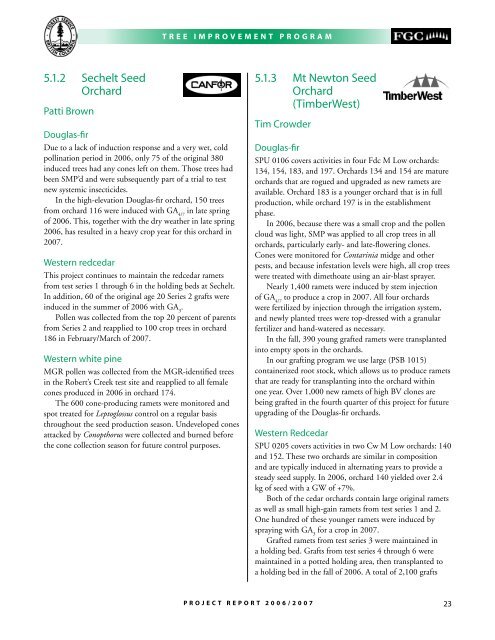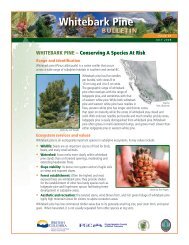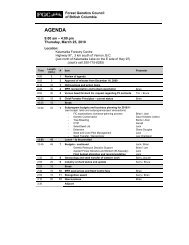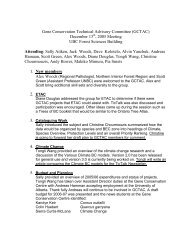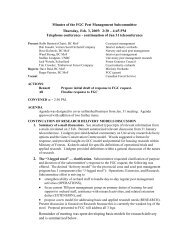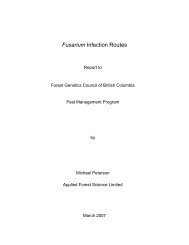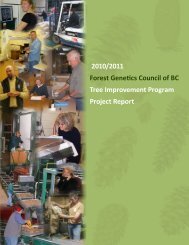Tree Improvement Program Project Report 2006 / 2007
Tree Improvement Program Project Report 2006 / 2007
Tree Improvement Program Project Report 2006 / 2007
You also want an ePaper? Increase the reach of your titles
YUMPU automatically turns print PDFs into web optimized ePapers that Google loves.
.1.2 Sechelt Seed<br />
Orchard<br />
Patt Brown<br />
Douglas-fir<br />
Due to a lack of induction response and a very wet, cold<br />
pollination period in <strong>2006</strong>, only 75 of the original 380<br />
induced trees had any cones left on them. Those trees had<br />
been SMP’d and were subsequently part of a trial to test<br />
new systemic insecticides.<br />
In the high-elevation Douglas-fir orchard, 150 trees<br />
from orchard 116 were induced with GA 4/7 in late spring<br />
of <strong>2006</strong>. This, together with the dry weather in late spring<br />
<strong>2006</strong>, has resulted in a heavy crop year for this orchard in<br />
<strong>2007</strong>.<br />
Western redcedar<br />
This project continues to maintain the redcedar ramets<br />
from test series 1 through 6 in the holding beds at Sechelt.<br />
In addition, 60 of the original age 20 Series 2 grafts were<br />
induced in the summer of <strong>2006</strong> with GA 3 .<br />
Pollen was collected from the top 20 percent of parents<br />
from Series 2 and reapplied to 100 crop trees in orchard<br />
186 in February/March of <strong>2007</strong>.<br />
Western wh te p ne<br />
MGR pollen was collected from the MGR-identified trees<br />
in the Robert’s Creek test site and reapplied to all female<br />
cones produced in <strong>2006</strong> in orchard 174.<br />
The 600 cone-producing ramets were monitored and<br />
spot treated for Leptoglossus control on a regular basis<br />
throughout the seed production season. Undeveloped cones<br />
attacked by Conopthorus were collected and burned before<br />
the cone collection season for future control purposes.<br />
T R E E I M P R O V E M E N T P R O G R A M<br />
P R O J E C T R E P O R T 2 0 0 6 / 2 0 0 7<br />
.1.3 Mt Newton Seed<br />
Orchard<br />
(T mberWest)<br />
T m Crowder<br />
Douglas-fir<br />
SPU 0106 covers activities in four Fdc M Low orchards:<br />
134, 154, 183, and 197. Orchards 134 and 154 are mature<br />
orchards that are rogued and upgraded as new ramets are<br />
available. Orchard 183 is a younger orchard that is in full<br />
production, while orchard 197 is in the establishment<br />
phase.<br />
In <strong>2006</strong>, because there was a small crop and the pollen<br />
cloud was light, SMP was applied to all crop trees in all<br />
orchards, particularly early- and late-flowering clones.<br />
Cones were monitored for Contarinia midge and other<br />
pests, and because infestation levels were high, all crop trees<br />
were treated with dimethoate using an air-blast sprayer.<br />
Nearly 1,400 ramets were induced by stem injection<br />
of GA 4/7 to produce a crop in <strong>2007</strong>. All four orchards<br />
were fertilized by injection through the irrigation system,<br />
and newly planted trees were top-dressed with a granular<br />
fertilizer and hand-watered as necessary.<br />
In the fall, 390 young grafted ramets were transplanted<br />
into empty spots in the orchards.<br />
In our grafting program we use large (PSB 1015)<br />
containerized root stock, which allows us to produce ramets<br />
that are ready for transplanting into the orchard within<br />
one year. Over 1,000 new ramets of high BV clones are<br />
being grafted in the fourth quarter of this project for future<br />
upgrading of the Douglas-fir orchards.<br />
Western Redcedar<br />
SPU 0205 covers activities in two Cw M Low orchards: 140<br />
and 152. These two orchards are similar in composition<br />
and are typically induced in alternating years to provide a<br />
steady seed supply. In <strong>2006</strong>, orchard 140 yielded over 2.4<br />
kg of seed with a GW of +7%.<br />
Both of the cedar orchards contain large original ramets<br />
as well as small high-gain ramets from test series 1 and 2.<br />
One hundred of these younger ramets were induced by<br />
spraying with GA 3 for a crop in <strong>2007</strong>.<br />
Grafted ramets from test series 3 were maintained in<br />
a holding bed. Grafts from test series 4 through 6 were<br />
maintained in a potted holding area, then transplanted to<br />
a holding bed in the fall of <strong>2006</strong>. A total of 2,100 grafts<br />
23


